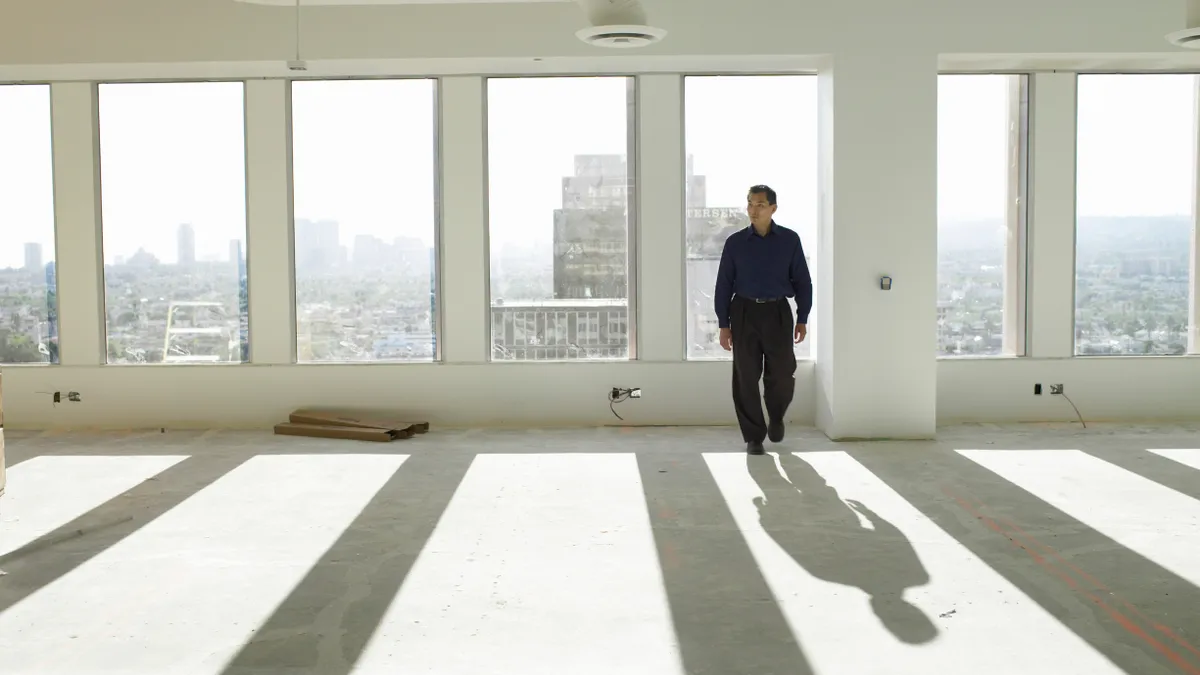Dive Brief:
- The work-from-home trend will likely push up the commercial property vacancy rate in 2026 to a peak average of 24%, or 4 percentage points higher than the first quarter of this year, according to Moody’s.
- Rising vacancies will probably erode the value of commercial property by as much as $250 billion by 2026, Tom LaSalvia and Todd Metcalfe, Moody’s economists who focus on CRE, said Friday in an email reply to questions.
- “For many industries, it appears that productivity has not been significantly affected” by work from home, they said, while acknowledging that studies on the issue have yielded mixed results. “Without a noticeable decrease in output, businesses may lack a strong incentive to revert to traditional office settings,” especially given cost savings from trimming office footprints.
Dive Insight:
U.S. commercial real estate will probably face greater turbulence this year and next as roughly $1 trillion in debt comes due, hybrid work erodes demand for office space and interest rates persist at higher levels than predicted, the Conference Board said last month.
An unusually high level of CRE debt is maturing after the price for office properties slumped more than 35% from its peak, the Conference Board said.
The value of office commercial real estate will likely plunge 26% by the end of next year as many companies adjust to the work-from-home trend by shrinking work space or moving to cheaper properties, Moody’s said in a March report.
CRE losses vary widely, even within some of the most troubled areas, Moody’s said in the recent report.
“Even in harder hit, expensive, established tech markets there are neighborhoods and buildings of success,” LaSalvia and Metcalfe said jointly in an email response to questions. “The most dangerous approach is to paint office [real estate] with a broad brush.”
Although overall delinquency rates on debt will probably approach the level seen during the 2008-2009 financial crisis, the commercial property market is “a story of haves and have-nots,” they said. An assessment of the market “requires a close monitoring of a stakeholders’ portfolios.”
McKinsey said in a July 2023 report that office use on a global basis had “stabilized” at 30% below the pre-pandemic level, with foot traffic near city stores 10% to 20% lower.
Demand for office space in the “median city” will fall 13% in 2030 from the 2019 level, McKinsey said. In a “severe scenario,” demand in the hardest hit city would slump 38%.
In the U.S., the vitality in some CRE markets is falling, LaSalvia and Metcalfe said.
“We are seeing evidence of a critical mass problem within buildings and neighborhoods, as tenants look to find space that is attractive to employees not interested in being in hollowed out buildings without nearby amenities and vibrancy,” they said.
“The brighter future for office is trending towards active, mixed-use neighborhoods,” according to LaSalvia and Metcalfe. “Even Class B buildings can succeed in these environments.”
At the same time, “the preference of many employees to work from home cannot be overlooked,” they said in the report, noting that a large portion of workers consider a mandate to return to the office similar to a pay cut.
Moreover, 28% of respondents to a Federal Reserve study between 2022-2023 said they would be highly likely to switch jobs if required to return to the office, the Moody’s economists said.
Over time, market forces will trim vacancies. “As office valuation declines are realized, conversions and teardowns will make more sense, which will act as a tailwind and put downward pressure on vacancy rates,” they said.
In the near term, “there are still many companies planning to return to the office at greater levels in 2024,” the Moody’s economists said. “This implies that currently higher WFH [work from home] full time and one- or two-day-a-week counts may also be short lived.”












